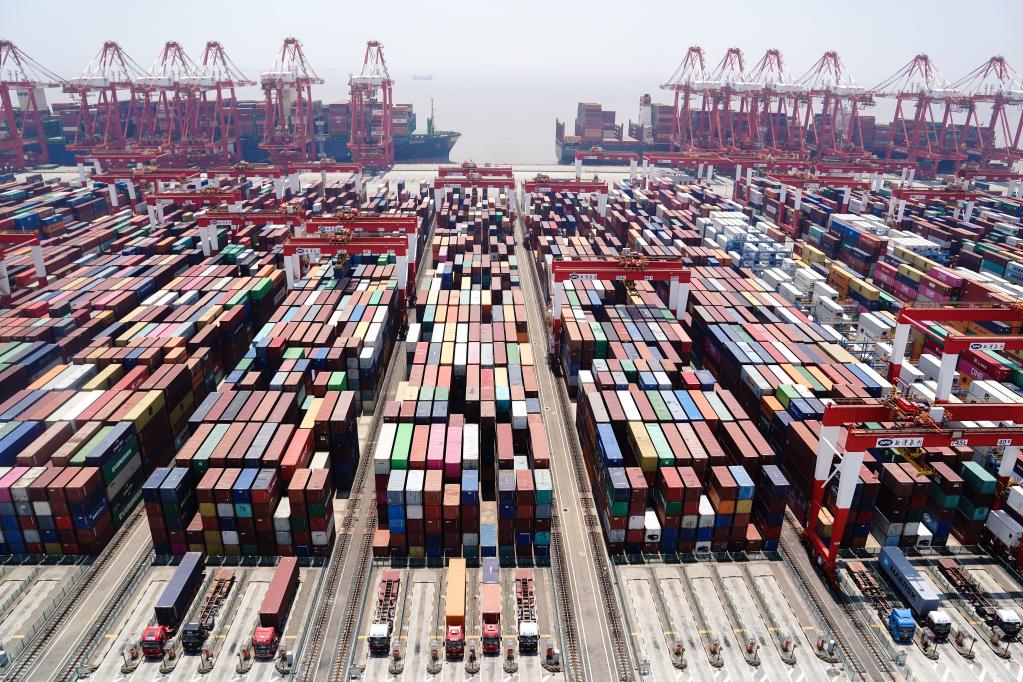Chinese economy has great resilience

Photo taken on May 17, 2022 shows a view of the automated container terminal of Shanghai Yangshan Deep Water Port in east China's Shanghai. (Xinhua/Ding Ting)
China is expected to see an overall improvement in its economic performance in 2023, according to the Central Economic Work Conference held in Beijing between Dec.15 and 16, 2022.
The meeting concluded that China’s economy has great resilience, potential, and vitality, and the results of previously implemented policies have been, and are continuously being realized.
Since the beginning of 2022, the Chinese economy has faced an increasingly complex and uncertain internal and external environment as the triple pressures of shrinking demand, disrupted supply chains and weakening expectations have continued to emerge, while the impact of other unexpected factors has grown.
In the face of this uncertainty, China has worked diligently to effectively contain COVID-19 while providing a stable economy and development security. With economic stability as a top priority, the country has made stable progression in development and continued along the path towards a modern socialist country in all respects.
By constantly optimizing and adjusting its COVID-19 prevention and control measures as well as diagnosis and treatment protocols, China has continuously put maximum efforts towards the prevention and control of the pandemic with minimum cost, maintaining fundamental conditions for the normal functioning of society and the economy.
This year, China has intensified efforts to assist businesses and reduce the effects of an uncertain economic environment while stabilizing expectations and boosting confidence. As of Nov. 10, China's tax refunds, as well as tax and fee cuts and deferrals, topped 3.7 trillion yuan (about $525.8 billion). By the end of November this year, the country’s outstanding loans to the real economy registered a 10.8-percent increase year on year, while the construction of more than 2,700 projects that have been backed by two batches of financial instruments (bringing in 739.9 billion yuan of investment) have kicked off.
During the first three quarters of this year, the number of newly-added market entities in China totaled nearly 22.02 million nationwide, up 3.1 percent year on year.
In the third quarter of 2022, the country’s GDP expanded 3.9 percent year on year, 3.5 percentage points higher than in the second quarter. On a quarterly basis, the country’s GDP grew by 3.9 percent after contracting by 2.7 percent in the second quarter of the year.
As the Chinese economy has become more stable and resilient, employment and prices in the country have been generally stable. The country has achieved its annual target of creating 11 million new jobs in urban areas throughout 2022. In spite of soaring global inflation, China’s consumer price index rose only 2 percent year on year during the first 11 months of the year, far lower than the increase in other major economies in the world.
“To build a modern socialist country in all respects, we must, first and foremost, pursue high-quality development,” Secretary General Xi Jinping said in his report to the 20th National Congress of the Communist Party of China.
On this journey to high-quality development, the country has witnessed dynamic, innovation-driven development, and remained committed to open development policies.
Major facilities of the country have continuously created new successes, and fruitful results have been achieved in sci-tech innovation. Some notable successes are: China's cargo spacecraft Tianzhou-5 successfully delivered supplies to the country’s space station; Deep Sea No.1, China's first self-operated 1,500-meter deep-water gas field, is operating day and night; Fendouzhe, or Striver, China's deep-sea manned submersible, set a national diving record of 10,909 meters in the Challenger Deep, a 11,000-meter chasm located at the bottom of the Mariana Trench in the western Pacific Ocean; and the country’s first nuclear power unit using Hualong One, a domestically designed third-generation reactor, has entered commercial operations.
From January to November of 2022, the total added value of China’s high-tech manufacturing enterprises above designated size grew 8 percent year on year, 4.2 percentage points higher than that of the country’s industries above designated size during the period.
The fifth China International Import Expo (CIIE) held in east China’s Shanghai in November this year brought together 284 Fortune Global 500 enterprises and industry-leading companies, while witnessing the debut of 438 new products, new technologies, and new services.
A total of $73.52 billion worth of tentative deals were reached for one-year purchases of goods and services at the fifth CIIE, representing a record high compared to that of the previous editions of the event.
The Central Economic Work Conference pointed out that China’s foundation for achieving economic recovery needs to be further consolidated, the triple pressures of demand contraction, supply shocks and weakening expectations are still considerable, and the external environment is volatile, combining to impact the Chinese economy on an ongoing basis.
Despite this, China remains in an important period of strategic opportunity for development, and sees opportunities while also facing challenges with contextual advantages in its favor.
China’s COVID-19 prevention and control measures have inevitably made a short-term impact on the country’s economic operations, but the Chinese economy has shown a strong capacity to supply, adapt and recover.
In 2020, the country achieved a steady and sustained economic recovery and became the first major economy to realize positive economic growth since the outbreak of the COVID-19 pandemic. In particular, central China’s Hubei Province, which was hit hard by COVID-19 in the beginning of 2020, saw its GDP surpass 5 trillion yuan in 2021, returning to the 7th spot in the country’s GDP ranking of provincial-level regions.
With the most complete industrial system and the largest consumer market in the world, as well as over 200 million skilled workers, China now has more solid material foundations than at any time in its history. China’s fundamental economic basis indicates that the country is much larger and more stable than may have previously been considered.
China’s reform and opening-up policy is a great source of vitality for the development of contemporary China. It’s believed that as long as China gives full play to reform and opening-up while developing a socialist market economy, promoting high-standards, and fostering a world-class business environment that is market-oriented, law-based, and internationalized, the country’s more than 160 million market entities are bound to unleash greater vitality.
Photos
Related Stories
- China’s economy boasts huge potential
- China’s economic recovery no scapegoat for Western energy crunch
- Chinese economy enjoys bright prospects
- Fiscal policy key to growth next year
- Key Party meeting decides major economic measures
- China to fully deliver supportive policies to consolidate economic recovery
- As global economy meets headwinds, China should focus on five areas to pursue economic growth: former IMF secretary
- High-quality growth envisioned
- Nation pushes high-level opening-up
- Chinese economy in stable recovery
Copyright © 2022 People's Daily Online. All Rights Reserved.









